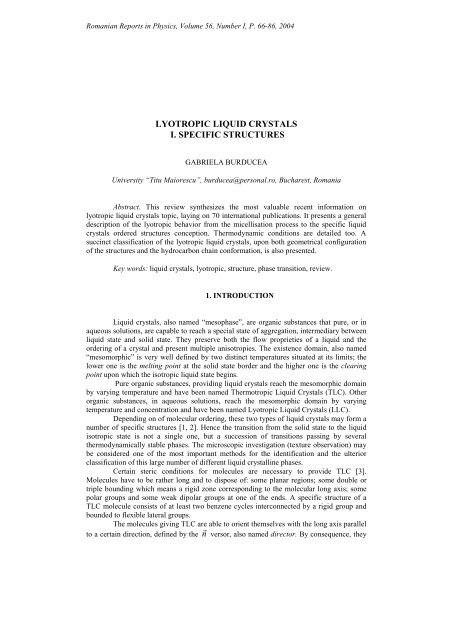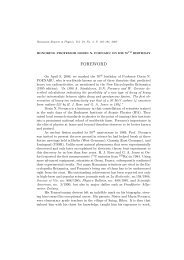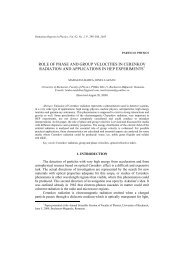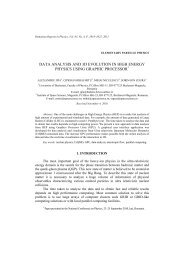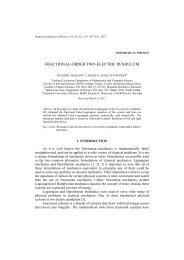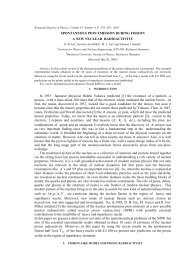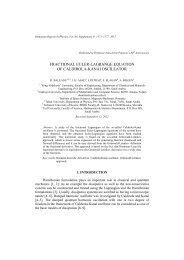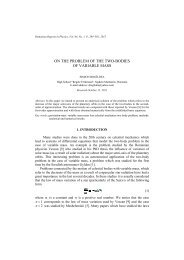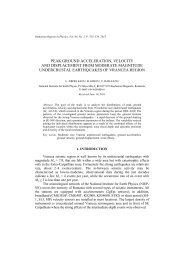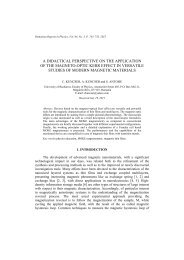lyotropic liquid crystals i. specific structures - Romanian Reports in ...
lyotropic liquid crystals i. specific structures - Romanian Reports in ...
lyotropic liquid crystals i. specific structures - Romanian Reports in ...
Create successful ePaper yourself
Turn your PDF publications into a flip-book with our unique Google optimized e-Paper software.
<strong>Romanian</strong> <strong>Reports</strong> <strong>in</strong> Physics, Volume 56, Number I, P. 66-86, 2004<br />
LYOTROPIC LIQUID CRYSTALS<br />
I. SPECIFIC STRUCTURES<br />
GABRIELA BURDUCEA<br />
University “Titu Maiorescu”, burducea@personal.ro, Bucharest, Romania<br />
Abstract. This review synthesizes the most valuable recent <strong>in</strong>formation on<br />
<strong>lyotropic</strong> <strong>liquid</strong> <strong>crystals</strong> topic, lay<strong>in</strong>g on 70 <strong>in</strong>ternational publications. It presents a general<br />
description of the <strong>lyotropic</strong> behavior from the micellisation process to the <strong>specific</strong> <strong>liquid</strong><br />
<strong>crystals</strong> ordered <strong>structures</strong> conception. Thermodynamic conditions are detailed too. A<br />
succ<strong>in</strong>ct classification of the <strong>lyotropic</strong> <strong>liquid</strong> <strong>crystals</strong>, upon both geometrical configuration<br />
of the <strong>structures</strong> and the hydrocarbon cha<strong>in</strong> conformation, is also presented.<br />
Key words: <strong>liquid</strong> <strong>crystals</strong>, <strong>lyotropic</strong>, structure, phase transition, review.<br />
1. INTRODUCTION<br />
Liquid <strong>crystals</strong>, also named “mesophase”, are organic substances that pure, or <strong>in</strong><br />
aqueous solutions, are capable to reach a special state of aggregation, <strong>in</strong>termediary between<br />
<strong>liquid</strong> state and solid state. They preserve both the flow proprieties of a <strong>liquid</strong> and the<br />
order<strong>in</strong>g of a crystal and present multiple anisotropies. The existence doma<strong>in</strong>, also named<br />
“mesomorphic” is very well def<strong>in</strong>ed by two dist<strong>in</strong>ct temperatures situated at its limits; the<br />
lower one is the melt<strong>in</strong>g po<strong>in</strong>t at the solid state border and the higher one is the clear<strong>in</strong>g<br />
po<strong>in</strong>t upon which the isotropic <strong>liquid</strong> state beg<strong>in</strong>s.<br />
Pure organic substances, provid<strong>in</strong>g <strong>liquid</strong> <strong>crystals</strong> reach the mesomorphic doma<strong>in</strong><br />
by vary<strong>in</strong>g temperature and have been named Thermotropic Liquid Crystals (TLC). Other<br />
organic substances, <strong>in</strong> aqueous solutions, reach the mesomorphic doma<strong>in</strong> by vary<strong>in</strong>g<br />
temperature and concentration and have been named Lyotropic Liquid Crystals (LLC).<br />
Depend<strong>in</strong>g on of molecular order<strong>in</strong>g, these two types of <strong>liquid</strong> <strong>crystals</strong> may form a<br />
number of <strong>specific</strong> <strong>structures</strong> [1, 2]. Hence the transition from the solid state to the <strong>liquid</strong><br />
isotropic state is not a s<strong>in</strong>gle one, but a succession of transitions pass<strong>in</strong>g by several<br />
thermodynamically stable phases. The microscopic <strong>in</strong>vestigation (texture observation) may<br />
be considered one of the most important methods for the identification and the ulterior<br />
classification of this large number of different <strong>liquid</strong> crystall<strong>in</strong>e phases.<br />
Certa<strong>in</strong> steric conditions for molecules are necessary to provide TLC [3].<br />
Molecules have to be rather long and to dispose of: some planar regions; some double or<br />
triple bound<strong>in</strong>g which means a rigid zone correspond<strong>in</strong>g to the molecular long axis; some<br />
polar groups and some weak dipolar groups at one of the ends. A <strong>specific</strong> structure of a<br />
TLC molecule consists of at least two benzene cycles <strong>in</strong>terconnected by a rigid group and<br />
bounded to flexible lateral groups.<br />
The molecules giv<strong>in</strong>g TLC are able to orient themselves with the long axis parallel<br />
to a certa<strong>in</strong> direction, def<strong>in</strong>ed by the n versor, also named director. By consequence, they
Lyotropic <strong>liquid</strong> <strong>crystals</strong>. I. Specific <strong>structures</strong><br />
can exist <strong>in</strong> a series of different <strong>structures</strong> such as nematic, smectic or cholesteric phases<br />
[4]. Each of them is def<strong>in</strong>ed by some order<strong>in</strong>g particularities: the nematic phase has a<br />
molecular parallel order<strong>in</strong>g but the structure is not stratified; the smectic phase has a planar<br />
stratified structure and the cholesteric phase has a helicoidally structure. TLC are of a great<br />
<strong>in</strong>terest as a research topic <strong>in</strong> physics and chemistry and have found applications <strong>in</strong> many<br />
other doma<strong>in</strong>s such as optical devices, nondestructive test<strong>in</strong>g of materials and medic<strong>in</strong>e<br />
(tissues thermography).<br />
Molecular species able to form LLC, also called amphiphilic or surfactants, have<br />
two dist<strong>in</strong>ct parts very much unlike as solubility. One part is hydrophilic, with a high<br />
solubility <strong>in</strong> polar solvents, while the other one is hydrophobic, with a high solubility <strong>in</strong><br />
hydrocarbon. This part of the molecule consists of long l<strong>in</strong>ear or ramified hydrocarbon<br />
cha<strong>in</strong>s with or without benzene cycles. This is a good reason to imag<strong>in</strong>e such a molecule as<br />
a little sphere represent<strong>in</strong>g the hydrophilic “head” cont<strong>in</strong>ued with a long zigzag “tale”<br />
represent<strong>in</strong>g the hydrophobic cha<strong>in</strong>. Conform<strong>in</strong>g to the nature of the hydrophilic part, the<br />
amphiphilic molecule may belong to one of the follow<strong>in</strong>g types: ionic, nonionic, or<br />
zwitterionic.<br />
In solution, at certa<strong>in</strong> concentrations, the amphiphilic molecules form aggregates<br />
with different shapes, which become structural units and by order<strong>in</strong>g lead to <strong>specific</strong><br />
<strong>structures</strong>, such as lamellar, cubic, hexagonal, nematic or cholesteric. Like for thermotropic,<br />
<strong>lyotropic</strong> order<strong>in</strong>g is characterized by the n director.<br />
Parameters describ<strong>in</strong>g the <strong>lyotropic</strong> mesomorphism are <strong>in</strong>vestigated by multiple<br />
experimental techniques such as optical microscopy <strong>in</strong> polarized light, neutron scatter<strong>in</strong>g or<br />
fluorescence quench<strong>in</strong>g. Complementary <strong>in</strong>vestigations about molecular organization and<br />
motion <strong>in</strong> LLC can be obta<strong>in</strong>ed from X-ray structural analysis and from magnetic resonance<br />
studies of deuterated compounds.<br />
The ma<strong>in</strong> <strong>lyotropic</strong> surfactants are of two types: soaps and phospholipids. Lately,<br />
LLC have become very important <strong>in</strong> the biomedical research too [5, 6], because of the great<br />
number of liv<strong>in</strong>g <strong>structures</strong> implied: cell membrane and vesicles [7], myel<strong>in</strong> [8], muscles<br />
and red cells [9], nucleic acids [10, 11, 12], etc.<br />
For a long time, the study of TLC and LLC was <strong>in</strong>dependently performed and<br />
made the <strong>in</strong>terest of the colloidal chemistry research. Physicists too have shown very much<br />
<strong>in</strong>terest to this area and they started a susta<strong>in</strong>ed and profound comparative study, f<strong>in</strong>alized<br />
by a large number of publications.<br />
In this paper, only the <strong>lyotropic</strong> <strong>liquid</strong> <strong>crystals</strong> field will be <strong>in</strong>vestigated.<br />
In Section 2, the aggregation process is discussed <strong>in</strong> terms of temperature,<br />
concentration and pack<strong>in</strong>g parameter; thermodynamic conditions are also detailed. In<br />
Section 3, the classification of the LLC based upon the geometrical configuration of the<br />
aggregates order<strong>in</strong>g <strong>in</strong> different <strong>structures</strong> and the conformational aspect of the<br />
hydrocarbon cha<strong>in</strong> are presented.<br />
2. MICELLAR SOLUTIONS<br />
Temperature, as an important parameter, conditions the appearance of a certa<strong>in</strong><br />
phase, both <strong>in</strong> thermotropic and <strong>lyotropic</strong> <strong>liquid</strong> <strong>crystals</strong>, but because <strong>lyotropic</strong>s are<br />
solutions of at least two compounds, temperature is not the determ<strong>in</strong>ant parameter, but the<br />
concentration. Further discussions about <strong>lyotropic</strong>s imply water as high polarity solvent<br />
[13] and whenever solutions will conta<strong>in</strong> more than two compounds, it will be specified.
68<br />
Gabriela Burducea<br />
Up to a certa<strong>in</strong> concentration named critical micelle concentration (CMC),<br />
<strong>lyotropic</strong>s did not yet aggregate, the molecular disorder still exist<strong>in</strong>g. At the CMC value, a<br />
spontaneous organization network of the amphiphilic molecules beg<strong>in</strong>s and molecular<br />
aggregates of colloidal sizes appear; they have been called “association micelles”. But the<br />
solution did not yet show <strong>liquid</strong> <strong>crystals</strong> behavior and is called “isotropic micellar solution”<br />
(IS). If the concentration <strong>in</strong>creases more, <strong>lyotropic</strong> <strong>specific</strong> <strong>structures</strong> appear with a<br />
structural order even up to three dimensions and the solution becomes an anisotropic one,<br />
more or less viscous. Only <strong>in</strong> this case, the micellar solution is a <strong>liquid</strong> crystal.<br />
The micellar aggregates conta<strong>in</strong> a large number of monomers depend<strong>in</strong>g on the<br />
chemical composition of the surfactant, the aggregate shape, the temperature and the<br />
concentration.<br />
Experimental observations, performed by fluorescence quench<strong>in</strong>g [14], NMR [15],<br />
and small angle scatter<strong>in</strong>g measurements [16], give an aggregation number N of ~60 for<br />
monovalent surfactant with 11 methylene groups <strong>in</strong> the alkyl cha<strong>in</strong> and ~80 for divalent<br />
surfactant with 14 methylene groups. Typical surfactants from the first k<strong>in</strong>d, as SDS<br />
(sodium dodecylsulphate C 12<br />
SO 4<br />
Na), can have the aggregation number between 50 and<br />
100.<br />
The micellar aggregation is a dynamical process that supposes reversibility; each<br />
second, some 10 3 to 10 6 monomers are tak<strong>in</strong>g part to the aggregation and <strong>in</strong> the same<br />
time, about 0.1 to 10 2 micelles are break<strong>in</strong>g up. Both processes rates are related to the<br />
CMC value and become faster as this one <strong>in</strong>creases. The micelle lifetime is about 10 −2<br />
to<br />
10 seconds [17, 18]. Both local molecular dynamics (flexions, torsions, isomeric rotations)<br />
and surface diffusion effects are superpos<strong>in</strong>g. The density of the medium essentially<br />
governs fast motions, while slow motions are more related to the local structural<br />
parameters. Development of macroscopic <strong>in</strong>vestigations, such as conductivity<br />
measurements or <strong>in</strong>frared spectroscopy of water and polar head bonds, can help the<br />
<strong>in</strong>terpretation of molecular dynamics.<br />
Temperature also, must be taken <strong>in</strong>to account for micelle aggregation, because it<br />
<strong>in</strong>troduces a new condition: it has to be lower than a certa<strong>in</strong> value, known as the “po<strong>in</strong>t<br />
Krafft” (PK), listed <strong>in</strong> Table 1 [19], together with the CMC values for various surfactants.<br />
In Table 1, substances <strong>in</strong> the first five l<strong>in</strong>es are nonionic surfactants and <strong>in</strong> the last three<br />
l<strong>in</strong>es are ionic surfactants; C n<br />
represents the number of carbon atoms of the alkyl cha<strong>in</strong><br />
and EO n<br />
represents the number of the ethylene oxide groups of the polar head.<br />
Table 1.<br />
Typical CMC values for some usual surfactants.<br />
Surfactant Krafft temp. CMC mol dm −3<br />
¡<br />
C 8<br />
EO 25<br />
6 9.9x10 −3<br />
C 10<br />
EO 20<br />
6 9.5x10 −4<br />
C 12<br />
EO 25<br />
6 6.8x10 −5<br />
C 12<br />
EO 25<br />
8 7.1x10 −5<br />
C 14<br />
EO 25<br />
8 9.0x10 −6
Lyotropic <strong>liquid</strong> <strong>crystals</strong>. I. Specific <strong>structures</strong><br />
C 8<br />
SO 4<br />
Na 25 1.3x10 −2<br />
C 12<br />
SO 4<br />
Na 25 8.3x10 −3<br />
C 16<br />
SO 4<br />
Na 25 2.1x10 −4<br />
Remark that, the CMC values reduce by a factor of 10 for each addition of two<br />
CH 2<br />
groups to the alkyl cha<strong>in</strong> for nonionic surfactants and of four CH 2<br />
groups to the alkyl<br />
cha<strong>in</strong> for monovalent ionic surfactants.<br />
The CMC was determ<strong>in</strong>ed from conductivity and pH measurements and it has been<br />
found that it is considerably higher for bivalent ionic surfactants than for monovalent<br />
analogues conta<strong>in</strong><strong>in</strong>g the same number of methylene groups <strong>in</strong> the alkyl cha<strong>in</strong>, probably<br />
depend<strong>in</strong>g on the <strong>in</strong>creas<strong>in</strong>g electrostatic repulsion between the polar headgroups [20]. For<br />
charged surfactants, the electrostatic <strong>in</strong>teractions are often the dom<strong>in</strong>at<strong>in</strong>g factor <strong>in</strong><br />
determ<strong>in</strong><strong>in</strong>g the properties of the systems. Comparison between monovalent and divalent<br />
amphiphilic molecules behavior <strong>in</strong> <strong>lyotropic</strong> solutions, demonstrates that physicochemical<br />
differences become important.<br />
Under the CMC value, some physical parameters such as density, electrical<br />
conductibility, osmotic pressure and boil temperature <strong>in</strong>crease with concentration, but<br />
present suddenly a significant variation upon the CMC value, as <strong>in</strong> Fig. 1, [21].<br />
At concentration higher than CMC value, most of the monomers form a film at the water<br />
surface till saturation. After that, a new equilibrium is established and the micellisation<br />
process generalizes <strong>in</strong> the bulk.
70<br />
Gabriela Burducea<br />
Fig. 1 - Sodium dodecyl sulphate physical properties behavior before and after reach<strong>in</strong>g the<br />
critical micellar concentration (hatched zone)<br />
The amphiphilic molecules free energy [22] may decrease considerably by<br />
form<strong>in</strong>g large aggregates (N>40). Chemical exchanges between monomers and micelles<br />
can be described by the chemical potential equilibrium:<br />
where<br />
0<br />
µ<br />
1<br />
and<br />
0<br />
µ 1<br />
+ k B<br />
Tln χ 1<br />
=<br />
0<br />
µ<br />
m<br />
+<br />
kBT<br />
N<br />
χ<br />
N<br />
m<br />
ln (1)<br />
0<br />
µ<br />
m<br />
are chemical standard potentials for a free monomer and for a<br />
χ and χ<br />
m<br />
are the molar fractions of monomers and<br />
monomer <strong>in</strong> a micelle, respectively;<br />
1<br />
micelles, respectively; the logarithmic terms are the entropies of the mixtures <strong>in</strong> water and<br />
<strong>in</strong> micelles and N is the aggregation number.<br />
Suppos<strong>in</strong>g N is constant and known, one can determ<strong>in</strong>e the molar fraction of the<br />
micelle and the CMC value by impos<strong>in</strong>g the condition that the monomer concentration is<br />
maxima:
Lyotropic <strong>liquid</strong> <strong>crystals</strong>. I. Specific <strong>structures</strong><br />
¡¢£max<br />
0 0<br />
⎡ µ − ⎤<br />
1<br />
= exp ⎢−<br />
1<br />
µ<br />
m<br />
⎥<br />
⎣ k B<br />
T ⎦<br />
(2)<br />
The shape of the aggregates <strong>in</strong> isotropic micellar solutions is ord<strong>in</strong>ary spherical<br />
(globular) as shown <strong>in</strong> Fig. 2.<br />
Fig. 2 - Spherical micelle<br />
In a mesomorphic state, aggregates can have different other shapes, such as<br />
cyl<strong>in</strong>drical, rod-like or disc-like.<br />
In aqueous solutions micelles are called normal, mean<strong>in</strong>g that the head of the<br />
amphiphilic molecules are <strong>in</strong> contact with water molecules, while the hydrocarbon tails<br />
entirely occupies the <strong>in</strong>terior of the micelles. Below a certa<strong>in</strong> <strong>specific</strong> water content which<br />
appears to be determ<strong>in</strong>ed by the maximum capacity of the hydrophilic groups for b<strong>in</strong>d<strong>in</strong>g<br />
water, the two parts of the amphiphilic molecule <strong>in</strong>terchange position and micelles become<br />
reversed. The same molecular arrangement also occurs at any concentration <strong>in</strong> all the<br />
solutions with nonpolar solvents.<br />
The aggregation shapes are submitted to a geometrical constra<strong>in</strong>t; one of the three<br />
dimensions must be limited by the value 2l, where l is the amphiphilic molecule length <strong>in</strong><br />
complete extension. That is why, the most convenient shape is the spherical one, but also<br />
rods, lamellae or discs are available.<br />
To classify and study those <strong>structures</strong>, the <strong>in</strong>troduction of a pack<strong>in</strong>g parameter P is<br />
imposed:<br />
v<br />
P =<br />
al<br />
(3)<br />
where v is the molecular volume and a is the medium area of the cross section of the polar<br />
head.<br />
For an amphiphilic micelle with a spherical shape of radius r, the total micellar<br />
area A and the volume V are:
72<br />
Gabriela Burducea<br />
A = Na = 4π r 2 and V = Nv =<br />
3<br />
4 π r<br />
3<br />
hence a = 3<br />
r<br />
v<br />
(4)<br />
Mak<strong>in</strong>g the same calculation for a cyl<strong>in</strong>drical micelle of radius r or a lamellar one<br />
of width 2r and ignor<strong>in</strong>g the edge effect, the possible values of the medium area of the cross<br />
section of the polar head a and the pack<strong>in</strong>g parameter P are:<br />
a ≥ 3<br />
r<br />
v<br />
a ≥ 2<br />
r<br />
v<br />
and P <<br />
3<br />
1<br />
and P <<br />
2<br />
1<br />
for spherical aggregates (radius r) (5)<br />
for cyl<strong>in</strong>drical aggregates (radius r) (6)<br />
a ≥ r<br />
v<br />
and<br />
1 < P < 1 for lamellae or discs (width 2r) (7)<br />
2<br />
For molecules with a certa<strong>in</strong> hydrocarbon cha<strong>in</strong> length, the pack<strong>in</strong>g pattern<br />
strongly depends on the size of the polar head. All shapes just mentioned are possible if the<br />
values a are large enough; if not, only the disc shape is available. The great flexibility of the<br />
hydrocarbon cha<strong>in</strong>s, make impossible the estimation of the smallest values for r which<br />
implies certa<strong>in</strong> difficulties to precisely def<strong>in</strong>e the maximal values for a.<br />
Both theoretical and experimental observation [23] show that surfactants with the<br />
head composed by many groups regularly form spherical micelles, those composed by less<br />
groups form rods and those composed by even less groups, form discs. At the CMC, the<br />
entropy favors the aggregation and smaller aggregates are preferred, i.e. spheres to rods and<br />
rods to discs.<br />
The micellar aggregation is the result of a complex process, called the hydrophobic<br />
effect, which describes the <strong>in</strong>teraction between nonpolar surfactants and water. It is well<br />
known that nonpolar surfactants are almost <strong>in</strong>soluble <strong>in</strong> water and generally have a very<br />
small degree of solubility.<br />
A thermodynamic analyze of the process shows that the immersion of hydrocarbon<br />
<strong>in</strong> water at room temperature, can be always associated to an <strong>in</strong>creas<strong>in</strong>g entropy, a<br />
decreas<strong>in</strong>g to zero enthalpy and a result<strong>in</strong>g high positive free energy.<br />
In a series of recent publications [24, 25, 26], this matter is discussed <strong>in</strong> detail.<br />
They consider the hydrophobic effect as a result of two contributions; the first one imposed<br />
by the surfactant order<strong>in</strong>g around water molecules and the second one imposed by the<br />
creation of a cavity <strong>in</strong> water, sufficiently large to <strong>in</strong>clude the nonpolar cha<strong>in</strong>s.<br />
The first contribution is associated with negative entropy, because water molecules,<br />
<strong>in</strong> the vic<strong>in</strong>ity of a nonpolar compound have less possible configurations than the “free<br />
water” and are not able to built hydrogen bridges with the solute. The strong hydrogen<br />
bridges between water molecules themselves justify small values of the enthalpy.<br />
The second contribution is justified by the high energy required by the construction<br />
of the nonpolar cavity <strong>in</strong> the water. On one hand, the energy value is large because of the<br />
higher degree of cohesion between water molecules through the hydrogen bridges and on<br />
the other hand, because of the smaller dimension of water molecules <strong>in</strong> comparison with<br />
those of the surfactant. The strong bound<strong>in</strong>g created by the hydrogen bridges that water<br />
provides, leads to a very high ordered aqueous structure.
Lyotropic <strong>liquid</strong> <strong>crystals</strong>. I. Specific <strong>structures</strong><br />
. The hydrophobic effect is very weak for nonpolar solutions, because of the<br />
repulsion that arises between water molecules and hydrocarbon or any other nonpolar<br />
groups. Otherwise, the order<strong>in</strong>g shall <strong>in</strong>crease, reduc<strong>in</strong>g the entropy.<br />
The <strong>specific</strong> micelle shape, clos<strong>in</strong>g <strong>in</strong>side the hydrocarbon tails of the amphiphilic<br />
molecules, favors the creation of a hydrocarbon zone, far from the water molecules.<br />
Hence, both thermodynamic conditions implied <strong>in</strong> the micellar stability are solved;<br />
the m<strong>in</strong>imization of the hydrophobic <strong>in</strong>teractions and the maximization of the hydrophilic<br />
<strong>in</strong>teractions as well.<br />
In aqueous solutions, the micellar surface is rather rough, because the heads of the<br />
amphiphilic molecules overcross the ideal geometrical micellar surface for about 0.2-0.5<br />
nm. The existence of small volumes between the polar heads <strong>in</strong>creases the possibility of<br />
counterions bound<strong>in</strong>g.<br />
The number of counterions <strong>in</strong> the diffuse layer decreases because of the very strong<br />
bound<strong>in</strong>g between them and amphiphilic ions of the surfactant, which contribution to the<br />
micellar superficial potential is of a great importance. That distribution favors the sudden<br />
decrease of the molar conductance and of the electrical conductibility near the CMC value.<br />
In nonpolar solvents, because of their small electrical permittivity, the micellar<br />
aggregation becomes more difficult. The <strong>in</strong>teractions with the solvent are weaker and the<br />
micelle aggregation pattern is of the reversed type; the polar heads form the micellar core<br />
while the alkyl cha<strong>in</strong>s form the micellar surface, contact<strong>in</strong>g the nonpolar solvent.<br />
The polar core of the reversed micelles develops cohesion on the behalf of the<br />
dipolar bound<strong>in</strong>g and the hydrogen bridges, <strong>in</strong> complete opposition with the hydrocarbon<br />
core of the normal micelles, where the ma<strong>in</strong>ly spherical shape supposes high osmotic<br />
pressure which conf<strong>in</strong>es the hydrocarbon tails and make them have different proprieties<br />
than the free surfactant molecules.<br />
In nonpolar solutions, the micellisation process does not beg<strong>in</strong> at the CMC value,<br />
but upper and the number of the micelles is rather smaller than the normal micelles formed<br />
<strong>in</strong> a polar solvent. The number of reversed micelles could <strong>in</strong>crease only <strong>in</strong> the presence of<br />
small quantities of water to solve the bound<strong>in</strong>g of the polar groups.<br />
In conclusion, decreas<strong>in</strong>g the surfactant concentration under CMC, leads to the<br />
micelle dissociation and the solution turns up to the <strong>in</strong>itial isotropic <strong>liquid</strong> state; at CMC,<br />
micellar solutions appear, but they are not yet <strong>liquid</strong> <strong>crystals</strong> because of order<strong>in</strong>g absence;<br />
<strong>in</strong>creas<strong>in</strong>g concentration leads to the extension of the micellar order<strong>in</strong>g till completely<br />
ordered phases appear, which really means the <strong>liquid</strong> crystal state. Temperature constra<strong>in</strong>ts<br />
are also imposed.<br />
3. LYOTROPIC ORDERING<br />
In order to identify all the <strong>lyotropic</strong> phases, there are some important methods of<br />
<strong>in</strong>vestigation, such as polarized light microscopy, X-ray scatter<strong>in</strong>g and RMN spectroscopy.<br />
Here are the different phases revealed by these methods; lamellar L, cubic I or V,<br />
hexagonal H, nematic N, cholesteric Ch and some <strong>in</strong>termediate ones.<br />
All of them, with one exception, are birefr<strong>in</strong>gent and present typical textures; the<br />
cubic phases are isotropic (like micellar solutions) so, they cannot be detected <strong>in</strong> polarized<br />
light <strong>in</strong>vestigation, but they have also a high viscosity, which make the difference. There is<br />
a particular phase, not yet mentioned named gel, where both the surfactant and the water<br />
have a very slow mobility, while mobility of all the other phases is high, like as <strong>liquid</strong>s.
74<br />
Gabriela Burducea<br />
Every phase dist<strong>in</strong>guishes from another by the <strong>specific</strong> long distance symmetry of<br />
the arrangement of the micellar aggregates and by the micellar surface curvature. Except<strong>in</strong>g<br />
the lamellar phase, with a planar molecular arrangement, all the other phases can be<br />
considered as cont<strong>in</strong>uous <strong>in</strong> the polar region, at least.<br />
Lyotropic phases can be found <strong>in</strong> a normal or a reversed state and the <strong>in</strong>dex 1 or 2<br />
respectively, will be attached to the appropriate phase symbol.<br />
One can found for the <strong>lyotropic</strong> phases, different other names belong<strong>in</strong>g to the<br />
usual soap manufacture terms, due to the direct application of that k<strong>in</strong>d of amphiphilic <strong>in</strong><br />
practical life.<br />
By add<strong>in</strong>g water to an amphiphilic crystal, the crystall<strong>in</strong>e structure turns <strong>in</strong>to a<br />
lamellar normal one, also called neat soap. If the water addition process cont<strong>in</strong>ues, the<br />
cubic normal phase also called viscous isotropic appears followed by the hexagonal normal<br />
phase also called middle soap and then the micellar isotropic <strong>liquid</strong> state, present<strong>in</strong>g<br />
association micelles, is obta<strong>in</strong>ed.<br />
Not all amphiphilic surfactants have the same phase succession as presented here,<br />
but the hydration process always f<strong>in</strong>alizes by the isotropic <strong>liquid</strong> state for all of them.<br />
Amphiphilic aggregates are always associated <strong>in</strong> such a structure to fulfill the free<br />
energy m<strong>in</strong>ima. The ma<strong>in</strong> forces implied <strong>in</strong> these <strong>structures</strong> are electrostatic and dispersive.<br />
The dispersive are generally weak forces, but sometimes they may govern the order<strong>in</strong>g<br />
<strong>in</strong>teractions between molecules. The electrostatic are attractive forces between ions or<br />
dipoles (ion-ion, dipole-dipole, and ion-dipole). Increas<strong>in</strong>g temperature may destroy these<br />
arrangements.<br />
Depend<strong>in</strong>g on temperature and concentration, all <strong>lyotropic</strong> phases can occur <strong>in</strong> the<br />
same solution pass<strong>in</strong>g by multiple phase transitions.<br />
In this section, the <strong>lyotropic</strong> order<strong>in</strong>g is discussed <strong>in</strong> two dist<strong>in</strong>ct paragraphs; <strong>in</strong> the<br />
first one (3.1), the ma<strong>in</strong> characteristics of all mentioned phases are detailed, while <strong>in</strong> the<br />
second one (3.2), a supplementary phase typology is revealed by means of the multiple<br />
conformational states of the hydrocarbon cha<strong>in</strong>, symbolized by<br />
3.1 Specific Structures<br />
3.1.1. Lamellar structure – Neat soap<br />
α , β,<br />
β′ , δ , αβ and γ .<br />
The structural unit for the lamellar phase is the simple and double layers. It has to<br />
be mentioned that the bilayer, as a repetitive unit, forms the ma<strong>in</strong> matrix of the biological<br />
membranes that conta<strong>in</strong> phospholipids as <strong>lyotropic</strong> compounds and not soaps.<br />
The ordered bilayer structure is formed by amphiphilic molecules disposed <strong>in</strong> bidimensional<br />
<strong>in</strong>f<strong>in</strong>ite layers, delimited by water layers, all of them hav<strong>in</strong>g a parallel<br />
disposition. The ionic heads of the molecules are contact<strong>in</strong>g the aqueous medium, while the<br />
hydrocarbon cha<strong>in</strong>s are <strong>in</strong>terdigitat<strong>in</strong>g <strong>in</strong> order to avoid water. The bilayers are disposed one<br />
under another through the third dimension, periodically alternat<strong>in</strong>g with water layers, like <strong>in</strong><br />
Fig. 3 [27].<br />
Because the bilayer order<strong>in</strong>g is not disturbed by the gravitational effect, the<br />
repetitive vertical distance between layers is constant. This phase is not a viscous one and<br />
the bilayers can slip easily one on the other. The <strong>specific</strong> optical characteristics of its<br />
textures make easier the identification of this phase.<br />
The optical axis is parallel to the long axis of the molecules of the layers; the phase<br />
can be optically uniaxial, positive or negative, depend<strong>in</strong>g on the temperature values.
Lyotropic <strong>liquid</strong> <strong>crystals</strong>. I. Specific <strong>structures</strong><br />
(a) (b) (c)<br />
Fig. 3 - Lamellar structure: (a) bilayer, (b) monolayer, (c) rippled bilayer; arrows <strong>in</strong>dicate<br />
water layer location.<br />
The usual <strong>in</strong>vestigation method for the lamellar phase is the X-ray scatter<strong>in</strong>g that<br />
gives the follow<strong>in</strong>g results [28]: the width of the double layer is of 30-40 Å, smaller than the<br />
double of the amphiphilic molecule length; the width of the <strong>in</strong>tercalated water layers is of<br />
about 20 Å. These figures vary with temperature and concentration <strong>in</strong> the limits of the<br />
lamellar phase. The hydrocarbon cha<strong>in</strong> fold<strong>in</strong>g configuration or the tilt angle of the<br />
molecules <strong>in</strong> the layer determ<strong>in</strong>es the width variation.<br />
3.1.2. The cubic structure – Viscous Isotropic<br />
As the name of the structure <strong>in</strong>dicates, <strong>in</strong> that case, micelles arrange themselves <strong>in</strong><br />
a cubic pattern and show always three different pack<strong>in</strong>g forms: cubic, cubic face centered<br />
and cubic body centered. There are two dist<strong>in</strong>ct micellar aggregation shapes: the first one is<br />
spherical and forms the I phase while the second one is rod-like, <strong>in</strong>terconnected <strong>in</strong> a threedimensional<br />
scheme and form the V phase. Consider<strong>in</strong>g also the normal and the reversed<br />
arrangements <strong>in</strong> both I and V phases, f<strong>in</strong>ely they are four different cubic <strong>structures</strong> <strong>in</strong><br />
discussion.<br />
From an optical po<strong>in</strong>t of view, cubic phases present no texture, because they are<br />
isotropic and can be dist<strong>in</strong>guished from the isotropic micellar solutions only by their high<br />
viscosity.<br />
The cubic phases I and V can be correctly identified one from another by their<br />
precise location among other phases. In the hypothesis of <strong>in</strong>creas<strong>in</strong>g progressively the<br />
surfactant concentration, the I phase location is between the isotropic micellar solution and<br />
the hexagonal one, while the V phase location is between the hexagonal phase and the<br />
lamellar one.<br />
The I phase has the simplest configurations; all three mentioned pack<strong>in</strong>g forms are<br />
present for <strong>in</strong>stance <strong>in</strong> the C 12<br />
EO 12<br />
/water solution <strong>in</strong> a normal I 1<br />
arrangement. For that<br />
nonionic surfactant solution, a polyhedral representation <strong>in</strong> all three pack<strong>in</strong>g forms (see Fig.<br />
4 [29]) has been appropriate.
76<br />
Gabriela Burducea<br />
(a) (b) (c) (d)<br />
Fig. 4 - Cubic phases <strong>in</strong> a polyhedral micellar arrangement<br />
Configuration (a) has been the subject of several hypotheses concluded as the<br />
follow<strong>in</strong>g one: the polyhedral volume consists <strong>in</strong> two spherical micelles and six disc<br />
micelles. This pack<strong>in</strong>g network is convenient with the energetic stability condition too.<br />
Configurations (b) and (c) are very well described by consider<strong>in</strong>g identical micelles<br />
with quasispherical shape proposed by Seddon [30].<br />
There are surfactants that form the cubic I phase <strong>in</strong> a reversed I 2<br />
arrangement;<br />
micelles are supposed to be spherical, of two different sizes, disposed <strong>in</strong> the (d)<br />
configuration [31].<br />
In all reversed <strong>structures</strong>, the pack<strong>in</strong>g constra<strong>in</strong>t r
Lyotropic <strong>liquid</strong> <strong>crystals</strong>. I. Specific <strong>structures</strong><br />
If <strong>in</strong>creas<strong>in</strong>g solvent concentration <strong>in</strong> the cubic phase, the hexagonal phase occurs<br />
and forms normal <strong>structures</strong> H 1<br />
, or reversed <strong>structures</strong> H 2<br />
, accord<strong>in</strong>g to the solvent<br />
polarity.<br />
Micelles are very long aggregates, rod-like, which can have circular, square,<br />
rectangular or hexagonal cross sections. These rod-like aggregates are the structural unit of<br />
that structure.<br />
With no respect to the cont<strong>in</strong>uous medium nature, rods disperse with their<br />
long axis <strong>in</strong> a parallel disposition, creat<strong>in</strong>g hexagonal, tetragonal or orthorhomboidal<br />
patterns.<br />
The amphiphilic molecules arrangement is a radial one, around the rod long axis,<br />
with the polar groups exposed to the exterior <strong>in</strong> the H 1<br />
structure, or with the hydrophobic<br />
tails exposed to the exterior <strong>in</strong> the H 2<br />
structure; the cont<strong>in</strong>uous medium is water and<br />
hydrocarbon, respectively. Both the normal and the reversed types are shown <strong>in</strong> Fig. 6.<br />
(a)<br />
(b)<br />
Fig. 6 - Schematic representation of a normal (a) and reversed (b) hexagonal phase<br />
Us<strong>in</strong>g X-ray scatter<strong>in</strong>g [34], it has been found that normal rods have a diameter of<br />
1.3 to 2 bigger than the hydrophobic cha<strong>in</strong> length. The dimension of the separation zone<br />
between rods is <strong>in</strong> the 0.8-3 nm ranges for the reversed type, and up to 5 nm for the normal<br />
type. Both types show similar optical textures and present a higher viscosity <strong>in</strong> the<br />
hexagonal phase than <strong>in</strong> the lamellar phase.<br />
3.1.4. The nematic structure<br />
Certa<strong>in</strong> solutions of <strong>lyotropic</strong> surfactant present nematic <strong>structures</strong>, like<br />
thermotropic nematics, i.e. orient<strong>in</strong>g themselves <strong>in</strong> external magnetic field or under<br />
mechanical stress and show<strong>in</strong>g typical Schlieren textures when observed <strong>in</strong> polarized light.<br />
Lyonematic <strong>structures</strong> were discovered by Lawson and Flaut [35] by add<strong>in</strong>g the<br />
correspond<strong>in</strong>g alcohol to aqueous solutions of ionic surfactants with 8 and 10 carbon atoms<br />
of alkyl cha<strong>in</strong>. Many ionic ternary solutions such as SDS/decanol/water, sodium<br />
decylsulphate (SdS)/decanol/water and potassium laurate (KL)/decanol/water, form<br />
nematic <strong>structures</strong> <strong>in</strong> a relatively narrow concentration/temperature range. Other ionic<br />
surfactants, as short cha<strong>in</strong> fluorocarbon derivatives, show nematic phases <strong>in</strong> b<strong>in</strong>ary<br />
<strong>structures</strong> with water. The most extensively <strong>in</strong>vestigated example of these compounds is the<br />
cesium per-fluoro-octanoate (CsPFO).
78<br />
Gabriela Burducea<br />
Surfactants that give nematic phase usually have the polar head group of<br />
the type SO − 4 , CO − 2 , N(C 5 H 10 ) + or N (CH 3<br />
) + ; their alkyl tails have over 8 carbon<br />
atoms and are of no ramified type.<br />
An example of nonionic surfactant that forms a nematic structure <strong>in</strong> a b<strong>in</strong>ary<br />
aqueous solution is the C 16<br />
EO 8<br />
. Recently it was shown [36] that other nonionic<br />
surfactants, such as hexapolyethilenoxi triphenil derivatives, present lyonematic phases.<br />
Aggregates <strong>in</strong> the nematic phase are f<strong>in</strong>ite and anisotropic, due to the onedimensional<br />
order<strong>in</strong>g characterized by the director n , and present an important<br />
translational disorder.<br />
There are two different micelle shapes <strong>in</strong> nematics, as <strong>in</strong> Fig. 7 [37]:<br />
(a) (b) (c) (d)<br />
Fig. 7 - Representation of nematic phases: (a) discotic micelles like rounded bricks; (b)<br />
cross section <strong>in</strong> a discotic micelle show<strong>in</strong>g amphiphilic molecules distribution; (c) rod-like<br />
calamitic micelles; (d) cross section <strong>in</strong> cyl<strong>in</strong>drical micelle show<strong>in</strong>g amphiphilic molecules<br />
distribution<br />
Conclud<strong>in</strong>g the experimental observations, three types of nematic phases are<br />
implied: the nematic discotic phase N d<br />
, the nematic calamitic phase N c<br />
and the nematic<br />
biaxial phase N bx<br />
.<br />
Both N d<br />
and N c<br />
phases are optically uniaxial and the oriented<br />
samples <strong>in</strong>vestigations revealed that N d<br />
is uniaxial positive and N c<br />
is uniaxial negative<br />
[38, 39, 40].<br />
The discotic phase is formed by planar disc micelles and is related more to the<br />
lamellar phase, because micelles are built like rounded bricks or ruler shaped, rather than<br />
circular discs. The calamitic phase is formed by rod-like short micelles, and is related to the<br />
hexagonal phase.<br />
In a concentration/temperature representation, the biaxial nematic phase always<br />
occurs between N d<br />
and N c<br />
phases. By consequence, some authors are present<strong>in</strong>g it as a<br />
mixture of the two types of micelles found <strong>in</strong> that ones. The N bx<br />
phase has been found by<br />
Yu and Saupe [41] <strong>in</strong> the ternary solution KL/decanol/water <strong>in</strong> a narrow temperature<br />
doma<strong>in</strong> at a constant decanol concentration of 6.24% and has been studied <strong>in</strong> detail by<br />
Galerne et al [42, 43, 44].<br />
Accord<strong>in</strong>g to experimental observations, it has been found that the follow<strong>in</strong>g five<br />
lyonematic solutions only, present all three nematic phases:<br />
- potassium laurate/decanol/water [45, 46]<br />
- sodium decylsulphate/decanol/water [47,48]
Lyotropic <strong>liquid</strong> <strong>crystals</strong>. I. Specific <strong>structures</strong><br />
- potassium laurate/decylammonium chloride/water [49,50]<br />
- sodium decylsulphate/decanol/water/sodium sulphate [48]<br />
- sodium dodecylsulphate/decanol/water [51]<br />
The evidence of all three nematic phases was confirmed by conoscopic<br />
microscopy and RMN spectroscopy, after add<strong>in</strong>g deuterated water <strong>in</strong> small quantities.<br />
The microscopy <strong>in</strong> polarized light shows typical nematic Shlieren textures; a<br />
planar texture for the N c<br />
phase (as a monocrystal cut parallel to the optical axis) and a<br />
homotropic texture for the N d<br />
phase (as a monocrystal cut perpendicular to the optical<br />
axis). In order to improve the understand<strong>in</strong>g and study of the nematic textures and their<br />
dependence on concentration, Neto et al [52] proposes the gradient concentration method<br />
that better <strong>in</strong>dicates the phase succession.<br />
Lyotropic nematic <strong>structures</strong> are located between the well ordered phases<br />
(lamellar, cubic, hexagonal) and the completely disordered phases (micellar isotropic<br />
solutions).<br />
Recently, the N c<br />
phase of the KL/decanol/water solution was X-ray <strong>in</strong>vestigated<br />
[53] and it has been found that the micelle section is elliptical <strong>in</strong>stead of be<strong>in</strong>g circular, as<br />
the random distribution of potassium laurate and decanol molecules around the micelle long<br />
axis, <strong>in</strong>dicates.<br />
Extend<strong>in</strong>g this theory, the general geometric shape of a nematic micelle can be<br />
described by an ellipsoid with three axes, l 1<br />
, l 2<br />
, l 3<br />
. In this case, discotic and calamitic<br />
micelles appear only <strong>in</strong> the geometrical conditions l 1<br />
~ l 2<br />
> l 3<br />
and l 1<br />
> l 2<br />
~ l 3<br />
,<br />
respectively. The director n has the orientation of the l 3<br />
axis <strong>in</strong> the N d<br />
phase and of the<br />
l 1<br />
axis <strong>in</strong> the N c<br />
phase. The N bx<br />
phase is considered to have rhombohedra micelles with<br />
two axes and is characterized by two perpendicular directors, n and m . The first one<br />
describes the long axes order<strong>in</strong>g and the second one describes the short axes order<strong>in</strong>g [54,<br />
55]. Accord<strong>in</strong>g to the theory that the N bx<br />
phase could be a mixture of calamitic and discotic<br />
micelles, then n and m directors would characterize their own directors, respectively, as<br />
well as the global micelles order<strong>in</strong>g [56, 57]. In the N c<br />
phase micelles rotate around the<br />
long axes, <strong>in</strong> N d<br />
phase they rotate around the short axes, while <strong>in</strong> the N bx<br />
phase all<br />
rotations are frozen.<br />
Further measurements on <strong>lyotropic</strong> nematic phases [58] have revealed a more<br />
<strong>in</strong>terest<strong>in</strong>g approach of this controversial subject. With<strong>in</strong> a large <strong>in</strong>terval of temperature and<br />
concentration, the micelles ma<strong>in</strong>ly preserve two axes of symmetry and have, on average,<br />
the form of curved platelets (orthorhombic with three axes). Thus, only the different spatial<br />
and thermal orientational fluctuations of the platelets make the differentiation between<br />
phases, so that their result<strong>in</strong>g macroscopic symmetries become related to the probability<br />
distribution of orientation of the axes. That requires two directions, denoted by n and m ¡ ¡<br />
(headless vectors) associated with the Euler angles (<br />
β, γ ) and α , respectively. The<br />
probability distribution of the longest orthorhombic axis to be oriented <strong>in</strong> the direction n is<br />
<br />
expressed by P ( β, γ ) =∫ P ( n,<br />
m)<br />
dα<br />
. Figure 8 [58] shows the isotropic and nematic<br />
¡<br />
configurations <strong>in</strong> terms of this probability.
80<br />
Gabriela Burducea<br />
(a) (b) (c) (d)<br />
Fig. 8 - Probability distribution (<strong>in</strong>dicated by a double arrow) of the longest<br />
orthorhombic axis to be oriented <strong>in</strong> a given direction n , <strong>in</strong> the (a) isotropic, (b) N c<br />
, (c) N d<br />
and (d) N bx<br />
phase. In (b) and (c) the pair of figures symbolizes the evolution from the<br />
isotropic-like to the rod-like (b) and disc-like (c) configurations of P( n ); <strong>in</strong> (d), the two<br />
possible representations of P( n ¡ ) that possess three maxima (left) and three m<strong>in</strong>ima (right),<br />
illustrate the <strong>in</strong>termediary character of N bx<br />
phase symmetry with respect to N c<br />
and N d<br />
phases symmetries<br />
Nematic calamitic (b) and nematic discotic (c) representations <strong>in</strong> Fig. 8 can be<br />
equivalently replaced by revolution ellipsoids and the nematic biaxial (d), by an ellipsoid<br />
with three different axes, perfectly concordant with the other descriptions mentioned<br />
before. Accord<strong>in</strong>g to the X-ray and neutron diffraction measurements [59], the biaxial<br />
phase produces by a simple change of the micellar shape assumed to transform from a flat<br />
disc (N d<br />
) or an elongated cyl<strong>in</strong>der (N c<br />
) to a biaxial ellipsoid (N bx<br />
). This micelle shape<br />
malleability can also be the explanation of the fact that calamitic structure turns easily <strong>in</strong>to<br />
a discotic one by add<strong>in</strong>g only 0.3% sodium sulphate <strong>in</strong> the SDS ternary solution.<br />
As mentioned by Hendrix [54] and Verac<strong>in</strong>i [60], nematics can also be classified<br />
by their orientation <strong>in</strong> a magnetic field and then belong to one of the two follow<strong>in</strong>g types: to<br />
the type I, if the director orients parallel to the magnetic field, hav<strong>in</strong>g positive anisotropy of<br />
the magnetic susceptibility, or to the type II, if the director orients perpendicular to the<br />
magnetic field, hav<strong>in</strong>g negative anisotropy of the magnetic susceptibility.<br />
Changes of the relative concentration of the nematic solutions compounds imply<br />
changes of the anisotropy of the magnetic susceptibility sign [61]. The sign <strong>in</strong>version can<br />
be attributed to both the change of the molecular susceptibility sign and the change of the<br />
micellar aggregation state.<br />
As for thermotropics, when add<strong>in</strong>g very small quantities (even under 0.1% <strong>in</strong><br />
weight) of an optical active substance to lyonematics, they reach a new structural order<strong>in</strong>g<br />
and turn <strong>in</strong>to twisted nematics, conserv<strong>in</strong>g only the <strong>in</strong>itial micelle shape, while the structure<br />
becomes twisted <strong>in</strong> a spiral, like cholesterics. The optical active substance has to be watersoluble<br />
and to have bound<strong>in</strong>g capacities, like all the <strong>lyotropic</strong> solutions compounds.<br />
Experiments demonstrate that the sign of the optical activity of the added<br />
substance and the sign of the <strong>in</strong>duced optical activity <strong>in</strong> the nematic structure are not related<br />
[62]. RMN spectroscopy revealed that the variation of solution composition <strong>in</strong>duce<br />
dimensional changes of the micelles. It was found that the path of the spiral structure<br />
follows nearly this variation: it <strong>in</strong>creases with <strong>in</strong>creas<strong>in</strong>g amphiphilic concentration and<br />
decreases with decreas<strong>in</strong>g decanol concentration.
Lyotropic <strong>liquid</strong> <strong>crystals</strong>. I. Specific <strong>structures</strong><br />
The study of <strong>lyotropic</strong> nematics is very important for biophysics too, because of<br />
the great number of biological systems present<strong>in</strong>g nematic <strong>structures</strong>. In this case, the<br />
surfactant, <strong>in</strong> adjunction with prote<strong>in</strong>s, is organized <strong>in</strong> simple or multiples bilayers with the<br />
hydrophilic head po<strong>in</strong>t<strong>in</strong>g outwards; normal and reversed vesicles form as well.<br />
3.2. Hydrocarbon Cha<strong>in</strong> Conformation<br />
3.2.1, Liquid-like conformation: α type<br />
The α -type conformation of hydrocarbon cha<strong>in</strong> shows a high disorder <strong>in</strong> the<br />
hydrocarbon region, <strong>liquid</strong>-like, as it is shown <strong>in</strong> Fig. 9 [63]. However, the average of the<br />
cha<strong>in</strong> orientation is perpendicular to the amphiphilic-water <strong>in</strong>terface and improves with the<br />
decreas<strong>in</strong>g section of the polar head localized <strong>in</strong> the <strong>in</strong>terface.<br />
Even if X-ray scatter<strong>in</strong>g is not very suited for <strong>liquid</strong>s <strong>in</strong>vestigation, it supplies<br />
several valuable arguments that support the <strong>liquid</strong>-like conformation theory of <strong>lyotropic</strong>s<br />
[64]. Here are some of them: as for <strong>liquid</strong>s, a diffuse band is observed <strong>in</strong> the large angles<br />
scatter<strong>in</strong>g; <strong>in</strong> the nonlamellar phases, for geometrical considerations, the hydrocarbon<br />
disordered cha<strong>in</strong>s appear to be folded <strong>in</strong> an irregular way, <strong>in</strong> smaller spaces, than <strong>in</strong> the<br />
bilayers; <strong>in</strong> the lamellar phase, the width of the bilayers decreases by about 30% and a<br />
delocalization of the CH 3<br />
groups is observed, when pass<strong>in</strong>g from a more rigid<br />
conformation to an α -conformation.<br />
(a)<br />
(b)<br />
(c) (d) (e)<br />
Fig. 9 - Liquid-like conformation:<br />
(a) normal lamellar phase; (b) normal hexagonal phase; (c) reversed lamellar phase;<br />
(d) reversed hexagonal phase; (e) reversed cubic phase<br />
All the phases hav<strong>in</strong>g cha<strong>in</strong>s <strong>in</strong> <strong>liquid</strong>-like conformation, display a peculiar<br />
temperature effect when rais<strong>in</strong>g temperature. It consists <strong>in</strong> decreas<strong>in</strong>g values of the bilayer<br />
thickness (<strong>in</strong> the lamellar phase), or of the micelle diameter (<strong>in</strong> the nonlamellar phases)<br />
with an unusually high l<strong>in</strong>ear thermal coefficient (of the order of -10 −3<br />
K − 1 ) [64].
82<br />
Gabriela Burducea<br />
3.2.2. Ordered conformation: β , β ’ and δ type<br />
At not so high temperature, the hydrocarbon cha<strong>in</strong>s become very ordered. That<br />
implies that only rotations around the molecule axis are allowed. The aqueous medium<br />
<strong>in</strong>stead, is <strong>in</strong> a <strong>liquid</strong>-like conformation, without mobility restrictions, hav<strong>in</strong>g very rapid<br />
rotational and translational movements.<br />
In the lamellar phase, where amphiphilic are organized <strong>in</strong> bilayers, all three<br />
conformation types, β (parallel), β ’ (tilted) and δ (coiled <strong>in</strong>to helices), are possible as<br />
Fig. 10 [65] shows.<br />
(a)<br />
(b)<br />
(c)<br />
(d)<br />
(e)<br />
Fig. 10 - Lamellar phase with cha<strong>in</strong>s <strong>in</strong> ordered conformation:<br />
(a) structure of the L β<br />
phase with stiff and parallel cha<strong>in</strong>s; (b) structure of potassium<br />
soap (gel phase) with <strong>in</strong>terdigitat<strong>in</strong>g parallel cha<strong>in</strong>s; (c) structure of the L β '<br />
phase<br />
with tilted extended cha<strong>in</strong>s; (d) two-dimensional periodic structure of a rippled<br />
¡£¤¥¦§¨§¡¥©¥©¨©¢¡¦¥©£¦¨¦£¦§£<br />
¡¢£<br />
δ<br />
phase with a tetragonal<br />
lattice where the light l<strong>in</strong>es represent the hydrocarbon cha<strong>in</strong>s coiled <strong>in</strong>to helices with<br />
their axis perpendicular to the lamellae and the heavy l<strong>in</strong>es represent the polar groups if<br />
two adjacent layers <strong>in</strong> registry<br />
Such conformations have been observed <strong>in</strong> the lamellar phase <strong>in</strong> many <strong>lyotropic</strong><br />
solutions with amphiphilic molecules present<strong>in</strong>g one or two (different) alkyl cha<strong>in</strong>s.<br />
A rectangular lattice was observed with Rb soap, at low temperature and a square<br />
lattice L δ<br />
, with a side of 4.8 Å, was observed <strong>in</strong> dry lecith<strong>in</strong> [66], both with cha<strong>in</strong>s<br />
perpendicular to the lamellae. In the L δ<br />
, phase, the polar heads are ordered <strong>in</strong> a twodimensional<br />
lattice, with the same symmetry as the hydrocarbon cha<strong>in</strong>s.<br />
A hexagonal lattice (side 4.8 Å) appears most frequently with cha<strong>in</strong>s <strong>in</strong> β or β ’<br />
conformation <strong>in</strong> synthetic lecith<strong>in</strong>. The thickness of the bilayer is related to the alkyl cha<strong>in</strong><br />
with CH 2<br />
groups <strong>in</strong> extended trans-trans configurations; <strong>in</strong> the δ conformation, the
Lyotropic <strong>liquid</strong> <strong>crystals</strong>. I. Specific <strong>structures</strong><br />
thickness of the bilayer is smaller because cha<strong>in</strong>s are coiled <strong>in</strong>to helices. That demonstrates<br />
that the complete elongation of the cha<strong>in</strong>s does not determ<strong>in</strong>e the two- dimensional<br />
order<strong>in</strong>g.<br />
The rotational disorder is present <strong>in</strong> all configurations, except the rectangular<br />
lattice, where it may be partially frozen.<br />
In β and β ’ conformations, the CH 3<br />
groups of two adjacent hydrocarbon layers<br />
are <strong>in</strong> registry <strong>in</strong> the middle of the bilayer and form a th<strong>in</strong> <strong>liquid</strong>-like zone [20, 67].<br />
Concern<strong>in</strong>g the polar heads, a two-dimensional order<strong>in</strong>g was not yet revealed.<br />
Lamellae <strong>in</strong> β ’ conformation, represented <strong>in</strong> Fig. 10(d), are all distorted [66]<br />
because the distortion propagates from layer to layer. The lattice is two-dimensional, one<br />
dimension be<strong>in</strong>g the lamellar repeat<strong>in</strong>g distance and the other, the common periodicity of<br />
the distortion which is of hundreds of Angstroms. A very strong correlation was observed<br />
between lamellae; it may be <strong>in</strong>termediated through the water layer by the forces between<br />
polar head groups.<br />
Even if strong long range <strong>in</strong>teractions were observed <strong>in</strong> all three conformations <strong>in</strong><br />
discussion, <strong>in</strong>teractions at molecular level seems not to exist and three-dimensional<br />
order<strong>in</strong>g do not appear.<br />
3.2.3. Mixed conformation: α β and γ type<br />
Phases appear<strong>in</strong>g at high surfactant concentrations have the hydrocarbon cha<strong>in</strong>s <strong>in</strong><br />
a very rigid, ordered β conformation and the transition to the more fluid disordered α<br />
conformation supposes the existence of mixed doma<strong>in</strong>s, even for chemically homogenous<br />
cha<strong>in</strong>s. For example, dur<strong>in</strong>g the α → β conformation transition of the diacyl lipids, a<br />
segregation process of the heterogeneous cha<strong>in</strong>s takes place; the longest and the most<br />
saturated cha<strong>in</strong>s organize themselves <strong>in</strong> β microdoma<strong>in</strong>s, while the other cha<strong>in</strong>s rema<strong>in</strong> <strong>in</strong><br />
the α conformation. So, the α β cha<strong>in</strong> conformation is a disordered mosaic of α and<br />
β doma<strong>in</strong>s, as it is shown <strong>in</strong> Fig. 11 [68, 69] (a):<br />
(a)<br />
(b)<br />
Fig. 11 - Mixed conformations: (a) lipid lamellae of the L α<br />
β<br />
phase represent<strong>in</strong>g a<br />
¥¤¥ ¦§¨ ©£¢§¡¡¡ ¡§¥¤¢£¥<br />
¡¢£¤ §¢¥¤¥¤¥¢¥¨¡¨§¨£¤ ¥¤¥ ¦§¨<br />
γ<br />
©£¢§¡
84<br />
Gabriela Burducea<br />
Both α and β conformation microdoma<strong>in</strong>s are similar with those of <strong>in</strong>f<strong>in</strong>ite<br />
doma<strong>in</strong>s appear<strong>in</strong>g <strong>in</strong> L α<br />
and L β<br />
phases. The dimension of the α β microdoma<strong>in</strong>s is<br />
estimated to be of the order of hundreds of Angstroms.<br />
Sometimes, at high surfactant concentrations, the microdoma<strong>in</strong>s are organized <strong>in</strong> a<br />
two-dimensional lattice depend<strong>in</strong>g on the lamellar periodicity along z-axis and on the<br />
length of α and β conformation microdoma<strong>in</strong>s along the x-axis. That is the case of the<br />
γ conformation of the hydrocarbon cha<strong>in</strong>s, shown <strong>in</strong> Fig. 11(b). This k<strong>in</strong>d of lattice<br />
<strong>in</strong>volves the existence of very strong <strong>in</strong>teractions between lamellae, created by the polar<br />
head groups [70]. In Fig. 11(a), the water layers separat<strong>in</strong>g amphiphilic bilayers are<br />
sufficiently thick to h<strong>in</strong>der such <strong>in</strong>teractions.<br />
Acknowledgments. The author is very grateful to Dr. Rodica Moldovan for<br />
permanent support dur<strong>in</strong>g the elaboration of this work through valuable discussions about<br />
recent <strong>in</strong>ternational research on the <strong>lyotropic</strong> <strong>liquid</strong> <strong>crystals</strong> field and for fruitful comments<br />
on the manuscript.<br />
References<br />
1. P. G. de Gennes, The physics of <strong>liquid</strong> <strong>crystals</strong>, Oxford University Press, Oxford, (1993).<br />
2. S. Chandrasekhar, Liquid <strong>crystals</strong>, Cambridge Univ. Press, Cambridge, (1977).<br />
3. P. J. Coll<strong>in</strong>gs, Liquid <strong>crystals</strong>, nature’s delicate phase of matter, Pr<strong>in</strong>ceton University<br />
Press, Pr<strong>in</strong>ceton, (1990).<br />
4. A. de Vries, Mol. Cryst. Liq. Cryst. 24, 337, (1973).<br />
5. G. H. Brown, J. J. Wolken, Liquid <strong>crystals</strong> and biological <strong>structures</strong>, Academic Press,<br />
New York, (1979), p200.<br />
6. R. Lipowsky, E. Sackman, Eds., Handbook of biological physics, Elsevier Science,<br />
Netherlands, (1995)<br />
7. J. M. Seddon, R. H. Templer, CH3 <strong>in</strong> Structure and dynamics of membranes: From cells<br />
to vesicles, A. J. Hoff, Elsevier Science, Netherlands, (1995).<br />
8. E. Moldoveanu, D. Marta, G. Burducea, Apoptosis. Int. Symp. of Myelodisplasic<br />
Syndrome, Proc. 51-56, Paris, 15-17 may 2003.<br />
9. Y. Bouligand, Liquid <strong>crystals</strong> and their analogs <strong>in</strong> biological systems, Solid State<br />
Physics, supplement 14, (1978)<br />
10. S. Hoffmann, W. Witkowsky, Chirality –<br />
¡¢£¤¥¦§¨¢©¢©¢ -Helix, Spr<strong>in</strong>ger,<br />
Heidelberg, (1991) p 205.<br />
11. S. Hoffmann, W. Witkowsky, Reproduction of supramolecular structure, Kluwer,<br />
Dordrecht NATO ASI Ser. (1994) p 496.<br />
12. G. M. Palleos, J. Michas, Membrane-Nucleic Acids systems, Liq. Cryst. 11, 773, (1992)<br />
13. R. G. Laughl<strong>in</strong>, The aqueous phase behavior of surfactants, Academic Press, London,<br />
(1994).<br />
14. L. B. Johansson, O. Soderman, J. Phys. Chem., 91, 5275, (1987).<br />
15. O. Soderman, H. Walderhaug, U. Henriksson, P. Stilbs, J. Phys. Chem., 89, 3693,<br />
(1985).<br />
16. B. Cabane, R. Doplessix, T. Zemb, J. Phys. (Les Ulis, Fr), 46, 2161, (1985).<br />
17. J. Israelachvili, H. Wennerstrom, Langmuir, 6, 873, (1990).<br />
18. J. Israelachvili, H. Wennerstrom, J. Phys. Chem., 96, 520, (1992).<br />
19. J. H. Cl<strong>in</strong>t, Srfactant aggregation, Blackie, Glasgow, (1990).
Lyotropic <strong>liquid</strong> <strong>crystals</strong>. I. Specific <strong>structures</strong><br />
20. H. Hagslatt, O. Soderman, B. Jonsson, Langmuir, 10, 2177, (1994).<br />
21. D. Zeroca, R. Hoffmann, Langmuir, 2, 553, (1986).<br />
22. Z. X. Li, E .M. Lee R. K. Thomas, J. Penfold, J. Colloid Int. Sci. 187, 492, (1997).<br />
23. C. Tanford, The hydrophobic effect: Formation of micelles and biological membranes,<br />
Wiley Interscience, New York, (1980).<br />
24. M. Costas, B. Kronberg, R. Silveston, J. Chem., Soc. Farday Trans. 90 (11), 1513,<br />
(1994).<br />
25. B. Kronberg, M. Costas, R. Silveston, Pure Appl. Chem., 67(6), 897, (1995).<br />
26. B. Kronberg, M. Costas, R. Silveston, J. Disp., Sci. Technol. 15 (3), 333, (1994).<br />
27. Muscutariu, Cristale lichide si aplicatii, Ed. Tehnica, Bucarest, (1981).<br />
28. R. Lipowsky, E. Sakman, Eds., Handbook of biological physics, vol. 1b, Structure and<br />
dynamics of membrane, Generic and <strong>specific</strong> <strong>in</strong>teractions, Elsevier Science, Netherlands,<br />
(1995). ]. I.<br />
29. P. Sakya, J. M. Seddon, R, H, Templer, R. J. Mirk<strong>in</strong>, G. J. T. Tiddy, Langmuir, (1997).<br />
30. J. M. Seddon, E. A. Bartle, J. M<strong>in</strong>g<strong>in</strong>s, J. Phys. Condens. Matter 2, suppl. A, (1990).<br />
31. A. Gulik, H. Delacroix, G. Kischner, V. Luzatti, J. Phys. 2 France, 5, 445, (1995).<br />
32. V. Luzatti, P.A. Spegt, Nature, 215, 707, (1976).<br />
33. A. Tardieu, V. Luzatti, Biochim. Biophys. Acta, 11, 219, (1970).<br />
34. G. H. Brown, J. Jerome, F. Wolken, Liquid <strong>crystals</strong> and biological <strong>structures</strong>,<br />
Academic Press, (1979).<br />
35. K. D. Lawson, T. J. Flautt, Magnetically oriented <strong>lyotropic</strong> <strong>liquid</strong> <strong>crystals</strong> phases, J.<br />
Am. Chem. Soc. 89, 5489, (1967).<br />
36. N. Boden, R. Y. Bushby, C. Hardy, J. de Phys. Lett. 46, 325, (1985).<br />
37. B. Luhmann, H. F<strong>in</strong>kelmann, G. Rehage, Makromol. Chem. 186, 1059, (1985).<br />
38. J. Charvol<strong>in</strong>, Y. Hendrix, Liquid <strong>crystals</strong> of one- and two-dimensional order, Brel<strong>in</strong>,<br />
Heidelberg, New York, Spr<strong>in</strong>ger-Verlag, (1980), p 265.<br />
39. L. Q. Amaral, A. M. F. Neto, Mol. Cryst. & Liquid Cryst. 98, 285, (1983).<br />
40. M. Menti, G. Barbero, G. Bartol<strong>in</strong>o, T. Chiaranza, E. Simoni, Nuovo Cimento. Ser. D.<br />
3, 30, (1984).<br />
41. M. C. Holmes, P. Sotta, Y. Hendrix, B. Deloche, J. de Phys. 2 France,3,1735, (1993).<br />
42. A. M. F. Neto, L. Liebert, Y. Galerne, J. Phys. Chem, 89, 3737, (1985).<br />
43. J. Galerne, J. P. Marcerou, Temperature behavior of the order parameter <strong>in</strong>variants <strong>in</strong><br />
the uniaxial and biaxial phases of a <strong>lyotropic</strong> <strong>liquid</strong> crystal, Phys. Rev. E 23, 2109, (1983).<br />
44. J. Galerne, J. P. Marcerou, Temperature- concentration behavior of the order<br />
parameter <strong>in</strong> the nematic phases of a <strong>lyotropic</strong> <strong>liquid</strong> crystal, J. de Phys. 46, 589, (1985).<br />
45. A. Saupe, Nuovo Cimento, 3, 16, (1984).<br />
46. I. Furo, B. Halle, J. Chem. Phys. 91, 42, (1989).<br />
47. J. Jeener, P. Broecaert, Phys. Rev. 157, 232, (1967).<br />
48. S. Emid, J. Konijnendijk, J. Smidt, A. P<strong>in</strong>es, Physica, B 100, 215, (1980).<br />
49. I. Furo, B. Halle, L. E<strong>in</strong>arsson, Chem. Phys. Lett. 182, 547, (1991).<br />
50. P-O. Quist, B. Halle, I. Furo, Nuclear Sp<strong>in</strong> Relaxation <strong>in</strong> hexagonal <strong>lyotropic</strong> <strong>liquid</strong><br />
<strong>crystals</strong>, J. Chem. Phys. 95, 6945, (1991).<br />
51. P-O. Quist, B. Halle, I. Furo, Micelle size and order <strong>in</strong> <strong>lyotropic</strong> nematic phases from<br />
Nuclear Sp<strong>in</strong> Relaxation, Chem. Phys. 96(5), 3875, (1992).<br />
52. N. Boden, K. Radley, M. C. Holmes, Mol. Phys., 42, 493, (1981).<br />
53. Y. Hendrix, J. Charvol<strong>in</strong>, M. Rawiso, L. Liebert, M. C. Holmes, Anisotropic aggregates<br />
of amphiphilic molecules <strong>in</strong> <strong>lyotropic</strong> nemtaic phases, J. Phys. Chem., (1983).<br />
54. M. J. Freiser, Phys. Rev. Lett. 24, 1041, (1970).
86<br />
Gabriela Burducea<br />
55. Sh<strong>in</strong> Chen-Shyr, R. Alben, Lattice model for biaxial <strong>liquid</strong> <strong>crystals</strong>, J. Chem. Phys., 57,<br />
3055, (1972).<br />
56. R. Alben, J. Chem. Phys., 50, 4299, (1973).<br />
57. R. Alben, Phase transitions <strong>in</strong> a fluid of biaxial particules, Phys. Rev. Lett. 30, 778,<br />
(1973).<br />
58. P. Toledano, A. M. F. Neto, V. Lorman, B. Mettout, V. Dmitriev, Theory of the phase<br />
diagrams of <strong>lyotropic</strong> nematic and <strong>lyotropic</strong> cholesteric systems, Phys. Rev., E 52, 5040,<br />
(1995).<br />
59. M. C. Valente Lopes, A. M. F. Neto, Phys. Rev., A 38, 101,(1988).<br />
60. C. Verac<strong>in</strong>i, D. Catalano, Aggregates of amphiphiles <strong>in</strong> <strong>lyotropic</strong> <strong>liquid</strong> <strong>crystals</strong>,<br />
Kluwer Academic Publishers, (1994).<br />
61. J. Charvol<strong>in</strong>, A. M. Levelut, E. T. Samulski, Lyotropic nematics; molecular<br />
aggregation and susceptibilities, J. Phys. Lett., 40, 587, (1979).<br />
62. A. M. F. Neto, L. Liebert, A. M. Levelut, Study of ferocholesteric discotic and calamitic<br />
<strong>lyotropic</strong>s by optical microscopy and X-ray diffraction, J. de Phys., 45, 1505, (1985).<br />
63. J. Charvol<strong>in</strong>, A. Tardieu, Lyotropic <strong>liquid</strong> <strong>crystals</strong>; Structures and molecular motions,<br />
Solid State Phys. Supl. 14, (1973).<br />
64. V. Luzatti, A. Tardieu, D. Taup<strong>in</strong>, J. Mol. Biol., 64, 269, (1972).<br />
65. J. L. Ranck, L. Mateu, D. M. Sadler, A. Tardieu, T. Gulik-Krzywicki, V. Luzatti, J.<br />
Mol. Biol. 85, 249, (1974).<br />
66. A. Tardieu, V. Luzatti, F. C. Reman, J. Mol. Biol. 75, (1973).<br />
67. Y. E. Lev<strong>in</strong>e, M. H. G. Wilk<strong>in</strong>s, Nature, London, New Biol., (1971).<br />
68. P. A. W<strong>in</strong>sor, Liq. Cryst. Plast Cryst., 1, 199, (1974).<br />
69. Y. K. Lev<strong>in</strong>e, Prog. Biophys. Mol. Biol., 24, 1, (1972).<br />
70. J. Israelachvili, Intremolecular and surface forces, Academic Press, (1992).
Lyotropic <strong>liquid</strong> <strong>crystals</strong>. I. Specific <strong>structures</strong>


